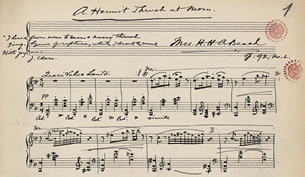
|| EARLY YEARS OF THE MACDOWELL COLONY || About this image
About this image
The MacDowell Colony quickly became recognized for artistic excellence. Many artists from the early years returned there often to work, including composer Amy Beach, painter Grant Reynard, poet Edwin Arlington Robinson, and writer Thornton Wilder.
![Amy Beach at The MacDowell Colony, [n.d.].](images/mc0015_305.jpg)
Amy Beach at The MacDowell Colony, [n.d.].
Bradford Bachrach. Gelatin silver print.
Prints and Photographs Division,
Library of Congress (15)
Digital ID# ppmsca-13429
© Made available online with permission of Robert D. Bachrach.

Amy Beach. “A Hermit Thrush at Morn,” 1921. Autograph score.
Arthur P. Schmidt Company Archives,
Music Division, Library of Congress (14)
Digital ID# mc0014
Courtesy of the MacDowell Colony
Song of the Hermit Thrush
Amy Beach (1867–1944) was known as the “Dean of American Women Composers” during her lifetime. A regular at The MacDowell Colony from 1921 until her death in 1944, she mentored many of the younger women composers who came to Peterborough. Her popular piano piece “A Hermit Thrush at Morn” is based on the song of a hermit thrush that she heard outside Watson Studio in 1921. Beach was a tireless promoter of the Colony, and on her death, she left The MacDowell Colony the rights to her music.

F. Tolles Chamberlin standing outside Adams Studio, ca. 1914.
Gelatin silver print.
Prints and Photographs Division,
Library of Congress (16)
Digital ID# ppmsca-13430
Frank Tolles Chamberlin
Frank Tolles Chamberlin (1873–1961) had recently returned from the American Academy in Rome when he first came to The MacDowell Colony in 1913, and he noted "the existence of more than a sentimental tie between the Academy and the MacDowell Association." Also an architect, Chamberlin designed Adams Studio, as well as Colony Hall and the Men’s Lodge, a new residence that was nicknamed "Mrs. MacDowell’s Folly" because it took eleven years to complete.

Hurdy Gurdy Ballet, 1928.
Lithograph. Glenn O. Coleman.
The Ben and Beatrice Goldstein Collection,
Prints and Photographs Division,
Library of Congress (17)
Digital ID# ppmsca-13431
An Artist in the City
Glenn Coleman’s talent for drawing brought him to New York City in 1905 to study painting with Robert Henri and Everett Shinn. He exhibited work in the 1913 Armory Show, and was a MacDowell Colony Fellow in 1917. Coleman’s lithographs are vibrant depictions of urban life. The smiling, dancing subjects of Hurdy Gurdy Ballet, however, belie the difficulties faced by Coleman, who struggled to find time to paint while working odd jobs to survive.

Edwin Arlington Robinson and former rabbi-turned-author Lewis Browne at The MacDowell Colony, ca. 1927.
Photograph.
Edward and Marian MacDowell Collection,
Music Division, Library of Congress (18)
Digital ID# mc0018
Courtesy of the MacDowell Colony

“Lancelot and Guinevere,” 1917.
Edwin Arlington Robinson.
Facsimile of autograph manuscript.
Manuscript Division,
Library of Congress (19)
Digital ID# mc0019
Edwin Arlington Robinson & Lewis Browne
Suspicious of anything called a “colony” poet Edwin Arlington Robinson (1869–1935) arrived in Peterborough in 1911 with a fake telegram in his pocket purporting an “emergency” should he wish to escape. He returned every year until his death in 1935. “MacDowell knew what he was about,” he wrote to a friend that July. “One summer of it in one of the isolated studios, with an open wood fire, would undo you for life.” Robinson won three Pulitzer Prizes during his lifetime.

Down the Hill, 1934.
Grant Reynard
Etching.
Prints and Photographs Division,
Library of Congress (24)
Digital ID# ppmsca-13432

Death Comes for the Archbishop. First edition.
Willa Cather.
Rare Book and Special Collections Division,
Library of Congress (21)
Digital ID# mc0021
![Portrait of Willa Cather, [n.d.].](images/mc0023_305.jpg)
Portrait of Willa Cather, [n.d.].
Photograph.
Edward and Marian MacDowell Collection,
Music Division,
Library of Congress (23)
Digital ID# mc0023
Courtesy of the MacDowell Colony
Willa Cather’s Advice to a Young Artist
Meeting Willa Cather (1873–1947) at The MacDowell Colony in 1926 made a big impression on artist and fellow Nebraskan Grant Reynard (1887–1963). Cather told him how her work took on a new dimension when she was suddenly overcome by a great wave of nostalgia for her early Nebraska days. Their conversation led Reynard to abandon his perceived "fine" subject matter and, like Cather’s writing in My Ántonia, explore his direct, personal experience. This kind of thinking was at the heart of the American Scene movement, which sought to capture everyday American life during the 1920s and 1940s.

Scottsboro Limited, November, 1931.
Prentiss Taylor.
Lithograph. Prints and Photographs Division (32)
Digital ID# ppmsca-13434
Art as Political Commentary
Illustrator, painter, and printmaker Prentiss Taylor (1907–1991) was at The MacDowell Colony between 1928–1930 and in 1932. He began his study of lithography at the Art Students League in New York in 1931. In the same year, Taylor illustrated Scottsboro Limited, a collection of poems and a protest play by Harlem Renaissance poet Langston Hughes. The image shown here also appeared on the cover of the December 1932 cover of the civil rights magazine The Crisis.

Thornton Wilder to Marian MacDowell, April 30, 1928.
Holograph letter.
Papers of Marian MacDowell, Manuscript Division,
Library of Congress. (26)
Digital ID# mc0026
By permission of Tappan Wilder. All rights reserved.

The Bridge of San Luis Rey.
Thornton Wilder.
New York: Albert & Charles Boni, 1927. First edition.
Rare Book and Special Collections Division,
Library of Congress (25) Digital ID# mc0025
By permission of Tappan Wilder. All rights reserved.
The Bridge of San Luis Rey
In 1926 a young teacher named Thornton Wilder came to The MacDowell Colony to work on his second novel, a story about a priest’s search for meaning in the accidental death of five people when a bridge collapses in Peru. The Bridge of San Luis Rey brought Wilder fame and earned him a Pulitzer Prize in 1928. Long sections of the book were written at The MacDowell Colony. Wilder reminisced about working on the book in this letter to Marian MacDowell from 1928.






